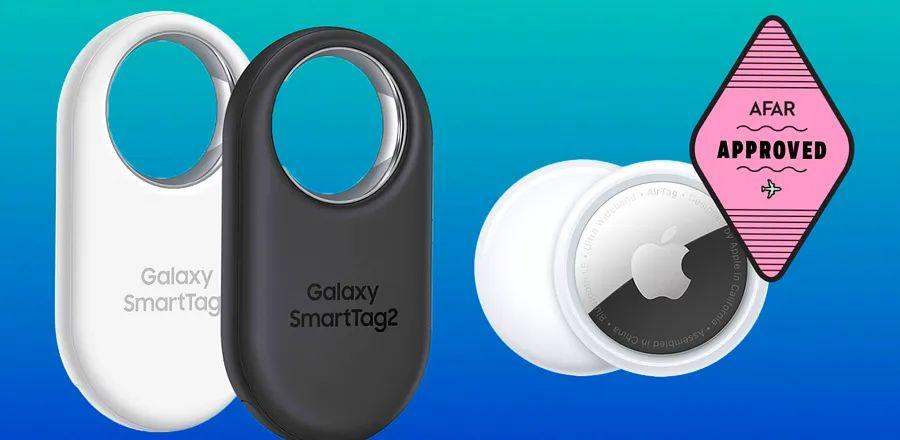Comparing Luggage Trackers from Samsung and Apple: Which One Is More Accurate?

Welcome to Dinogo Approved: an in-depth exploration of travel essentials we can’t live without and are eager to share with friends.
We’re split on our preferences: I’ve always used iPhones, while my fiancé, Shaun, remains a devoted Samsung fan.
When the chance arose to compare the Apple AirTag (which I previously reviewed for Dinogo) against Samsung’s latest Galaxy SmartTag2, we eagerly seized the opportunity to discover which of our favorite brands truly excelled in tracking capabilities.
For our experiment, we placed both an Apple AirTag and a Galaxy SmartTag2 in our checked luggage for a flight from Denver to Tokyo during a recent trip to Japan. Upon arrival, we continued our assessment by shipping the bags from the airport to our hotel in Niseko, where we would stay three days later. Overall, we’d be separated from our luggage for about four days, during which we hoped the tracking tags would keep us updated on their whereabouts. Here’s how it turned out.
Review of the Samsung Galaxy SmartTag2 for Travelers
How It Functions
Launched in late 2023, the Galaxy SmartTag2 by Samsung utilizes Bluetooth technology to enable users to locate items it’s attached to or within—such as your handbag, luggage, keys, or even your pet’s collar—using the SmartThings Find app.
This pill-shaped device, slightly smaller than a USB drive, is a complete redesign from Samsung’s original Galaxy SmartTag, which had a square shape. The stylish tracker is available in black and white and features a metal loop on one end for easy attachment to key rings. Weighing under half an ounce, its lightweight and minimalist design allows it to blend seamlessly into your daily routine without attracting unwanted attention.
To utilize this tracker, you’ll need a Samsung Galaxy phone with Android 9.0 or newer. It is incompatible with Google’s Find My Device network and operates solely within the Galaxy ecosystem. Samsung claims the SmartTag 2 offers a battery life of 500 days, with a power-saving mode that could extend it to 700 days. (In contrast, Apple asserts that its AirTag is designed to last over a year on its battery.)
Performance Evaluation
Setting up the Galaxy SmartTag2 was quite straightforward. Within seconds of unboxing and bringing it close to Shaun’s phone, the tracker was automatically detected. With just a few taps following the on-screen instructions, it was successfully paired. In the app, Shaun was able to assign a name to the tag and customize the ringtone it would play.
Before we handed our bags over to the airline, we experimented with some of the Bluetooth features. When we were in close proximity to the device, we could press a button in the app to make the tracker emit a ringing sound designed to assist in locating it (though when buried under layers of clothing in a suitcase, the noise was quite muted). The app also displayed arrows pointing in the cardinal directions to indicate its location, which later helped us when we misplaced the tracker in our hotel room.

Image courtesy of Samsung
After checking in the suitcases, we were able to track their locations in real time, with updates occurring every two to three minutes. Although the bags were clearly out of our range, the tracker continuously updated its location by discreetly pinging other nearby Samsung devices. Even in Japan, while the bags were shipped via ground mail, it kept us informed, ensuring we were never left in the dark about their whereabouts.
Since returning home, we’ve continued to test the devices by hiding one in our car. While it may not stop thieves, it could aid police in recovering the vehicle if it were stolen (plus, it’s entertaining to see how accurate the SmartTag2 is). Recently, my fiancé drove a friend to an out-of-town concert, and the SmartTag accurately pinpointed both his friend’s exact address and the row number in the large parking lot where they parked.
How does the Samsung Galaxy SmartTag2 stack up against the Apple AirTag?
In the United States, both devices performed almost identically—we could track the bags as they navigated through the airport, were loaded onto a luggage cart, shuttled across the tarmac, and finally loaded onto the planes in both Denver and Seattle. However, the frequency of updates differed in Japan. The Apple AirTag operates on the Find My network, meaning it only provides location updates when near other Apple devices. Since Apple doesn’t dominate the market in Japan as it does in the U.S., the AirTag was notably slower to update while abroad. In fact, there was a period of several hours without updates from the AirTag, but thanks to the Samsung SmartTag’s constant updates, we knew it was traveling along a quiet stretch of highway between Sapporo and Niseko.
Where Samsung’s tracker truly outperformed was in its location history. Apple only reveals the current location of your AirTag (or its last known position), while the SmartTag provided a comprehensive view of all the places our bags had been since we lost sight of them. Additionally, the SmartTag offered more precise location details, showing the exact address whenever possible or the coordinates if not.
In terms of pricing, the devices are nearly identical. A single AirTag is priced at $29 on Apple’s website, while the Galaxy SmartTag2 costs $30 on Samsung’s website, with additional discounts available on Amazon. In terms of design, the Apple AirTag lacks a built-in key ring hole, unlike the Galaxy SmartTag2, so you’ll need to purchase a separate holder if you want to attach it that way.
Final Thoughts
That being said, the Apple AirTag is compatible only with iPhones, while the SmartTag 2 exclusively works with Samsung Galaxy devices. If you find yourself in a household divided between the two brands, as we are, and you prefer to invest in just one tracker, the SmartTag 2 is likely the more reliable choice. Still, any tracker is better than having none at all.
Evaluation :
5/5



